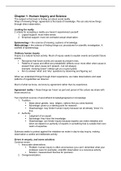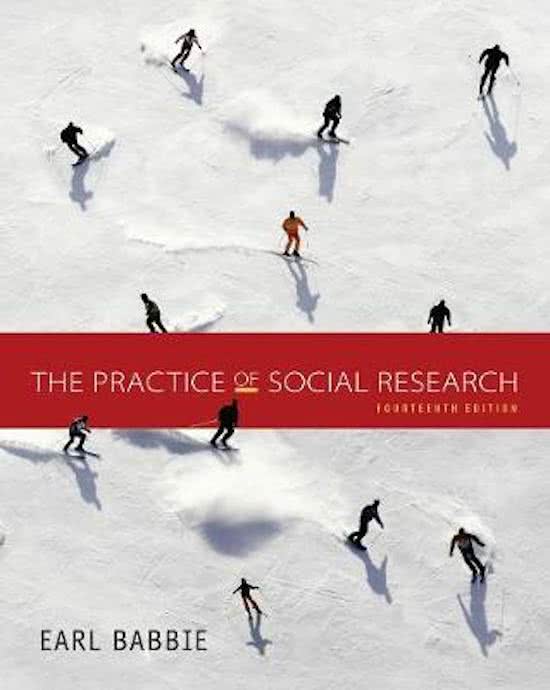Chapter 1: Human Inquiry and Science
The subject is this book is finding out about social reality.
Ways of knowing things: agreement is the basis of knowledge. We can also know things
through direct observation.
Looking for reality
2 criteria for accepting a reality you haven’t experienced yourself:
1. Logical support: must make sense.
2. Empirical support: must not contradict actual observation.
Epistemology = the science of knowing; systems of knowledge.
Methodology = the science of finding things out; procedures for scientific investigation. A
subfield of epistemology.
Ordinary human inquiry
Inquiry is a natural human activity. Much of inquiry seeks to explain events and predict future
events.
Recognize that future events are caused by present ones.
Patterns of cause and effect are probabilistic (effects occur more often when cause is
present than when cause isn’t present - but not always).
example: studying doesn’t always get you a good grade.
Aim to answer ‘what’ and ‘why’ questions by observing and figuring out.
When we understand things through direct experience, we make observations and seek
patterns of regularities we observe.
Much of what we know, we know by agreement rather than by experience.
Agreement reality = those things we ‘know’ as part and parcel of the culture we share with
those around us.
Two important sources of secondhand knowledge/agreed-on knowledge:
1. Tradition
Ideas about gender, race, religion, nations that you were learned.
Advantage: gives us a starting point for research.
Disadvantage: may hinder human inquiry because we all already ‘know’ it’s
true.
2. Authority
Judgment of an expert.
Advantage: they have the knowledge.
Disadvantage: can hinder inquiry because experts can make mistakes and
when we depend on authority of experts in something that is outside their own
realm of expertise.
Sciences seeks to protect against the mistakes we make in day-to-day inquiry: making
observation a careful and deliberate activity.
Errors in enquiry, and some solutions
Common errors
1. Inaccurate observations.
Problem: human inquiry is often unconscious (you can’t remember what your
professor wore for example), scientific observation is a conscious activity.
Solution: measurement devices for precision.
2. Overgeneralization.
, Problem: we think there is a general pattern based on limited observations.
Solution: large and representative sample of observations & replication
(repeating a research study to test and either confirm or question the findings
of an earlier study).
3. Selective observation.
Problem: we only focus on events and situations that fit the general pattern we
saw by overgeneralization.
Solution: find ‘deviant cases’ - cases who do not find in the general pattern.
4. Illogical reasoning.
Problem: illogical thinking, for example the saying ‘the exception that proves
the rule’ (exception can’t prove a rule: a nice businesswoman doesn’t prove
that all others are mean) and gambler’s fallacy (thinking that a consistent run
of good or bad luck foreshadows the opposite).
Solution: using systems of logic consciously and explicitly.
The foundations of social science
Science is characterized as logico-empirical; it has two pillars: (1) logic and (2) observation.
Theory = a systematic explanation for the observations that relate to a particular aspect of
life; for example social stratification, juvenile delinquency or political revolution.
Theory: logical aspect of science; systematic explanations.
Data collection: observational aspect of science.
Data analysis: looks for patterns in the observations and compares what is logically
expected and what is actually observed.
Theory, not philosophy or belief
Philosophy and belief: focus on how things are and why AND how things are ought to
be.
Science: focus on how things are and why, cannot settle debates about values.
Social regularities
Social science isn’t governed by regularities like physical sciences, but scientists do aim to
find patterns of regularity in social life and they do find them:
Formal norms.
For example: traffic laws make people drive on the right side, labor laws create
uniformity in minimum wages.
Social norms.
For example: men tend to earn more than women, professors tend to earn more than
unskilled laborers do.
3 objections for the social regularities
1. Some of the regularities seem trivial (onbeduidend)
2. Contradictory cases (exceptions) may be cited, indicating that the ‘regularity’ isn’t
totally regular.
3. People involved in the regularity could upset the whole thing if they wanted to (people
could interfere).
Weerlegging van de objections
1. Triviality (onbeduidendheid)
Documenting the obvious is a valuable function for science, what seems ‘obvious’
can be wrong.
2. Exceptions
, Exceptions don’t mean the regularity doesn’t exist or isn’t important.
Example: 1 woman may earn more money than most men, but women still earn less.
3. People could interfere
This does not pose a serious challenge to social science.
So social regularities do exist and can change over time.
Social research has a recursive quality: what we learn about society can end up changing
things so that what we learned is no longer true.
Example: report with ‘’10 best places to live’’ → people move there → places become
overcrowded and are no longer the best places to live.
Aggregates, not individuals
Regularities of social life reflect the collective behaviour of many individuals.
Social scientists focus on groups and the interaction between them.
Aggregate = groups, collectives, organizations, etc
Social scientists try to understand the systems in which people operate.
Concepts and variables
Variables = logical set of attributes. the variable sex is made up of the attributes male and
female.
Attributes = characteristics of people or things.
Social research is the study of variables and their relationships. People only get involved as
the ‘carriers’ of variables.
Independent variable = a variable with values that are not problematic in an analysis but are
taken as simply given. An independent variable is presumed to cause or determine a
dependent variable.
Example: amount of education (causes level of income).
Dependent variable = a variable assumed to depend on or caused by the independent
variable.
Example: income (caused by amount of education).
Independent variable = cause.
Dependent variable = effect.
The purposes of social research
1. Exploratory social research: help find topics for future social research.
2. Describing the state of social affairs.
3. Explanatory purpose: finding reasons for phenomena in the form of causal
relationships.
Studies can have more than one of these purposes.
Some dialects of social research
Idiographic and nomothetic explanation
Idiographic = an approach to explanation in which we seek to fully understand all the
causes of what happened in a particular event.
⇒ Examples: why did I fail an exam? → I wasn’t prepared, it was my worst subject,
my roommate kept me up all night, etc; given all these circumstances it’s no wonder I
did poorly.
, Nomothetic = an approach to explanation in which we seek to identify a few causal
factors that generally impact a class of conditions or events.
⇒ Examples: why do students fail exams? → Students who work in groups perform
better or students who are interested do better.
⇒ Focus on a class of situations or events, uses just a few explanatory factors and
settles for a partial rather than a full explanation.
Inductive and deductive theory
Induction = moves from the particular to the general, from a set of specific
observations to the discovery of a pattern of all the given events.
⇒ Example: Jews are more likely to vote Democratic than protestants → religious
minorities might be more affiliated with Democratic party in the United States.
Deduction = moves from the general to the particular, moves from a pattern that
might be logically or theoretically expected to observations that test whether the
expected pattern actually occurs.
⇒ Example: all deans are mean → you anticipate that this dean won’t let you change
courses.
Determinism versus agency
Are humans determined by their environment or do they act out of personal choice/agency?
No ultimate answer, but concludingly (1) each of us possess considerable free
choice/agency and (2) we allow ourselves to be controlled by environmental factors.
Tolerance for ambiguity = ability to hold conflicting ideas in your mind simultaneously,
without denying or dismissing any of them.
Example: you know you have influence on your life, but you also know social forces around
you have a lot of power.
The underlying logic of traditional science implicitly suggests a deterministic cause and effect
relationships, in which individuals have no choice, though researchers do not say nor
necessarily believe that (free will versus determinism debate).
Qualitative and quantitative data
Quantitative data = numerical data.
Advantage: makes observations explicit, makes it easier to aggregate, compare and
summarize data.
Disadvantage: loss in richness of meaning (for example: age doesn’t necessarily say
something about maturity).
Qualitative data: non numerical data.
Advantage: richness in meaning.
Disadvantage: purely verbal description, hard to measure things like ‘maturity.’
Both are useful for different research purposes.
The Research Proposal
Preparation of a research proposal: describing the purpose and methods of the
proposed study.
Chapter 2: Paradigms, Theory and Social Research.
Theories function in 3 ways in research:





